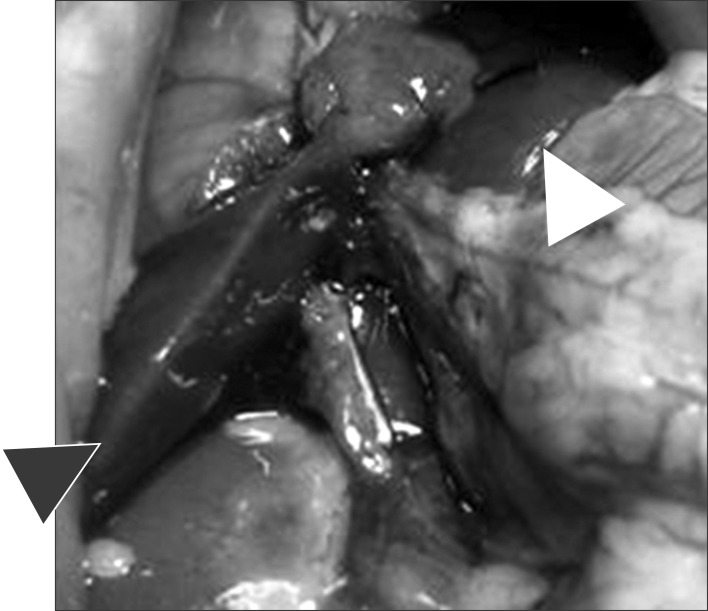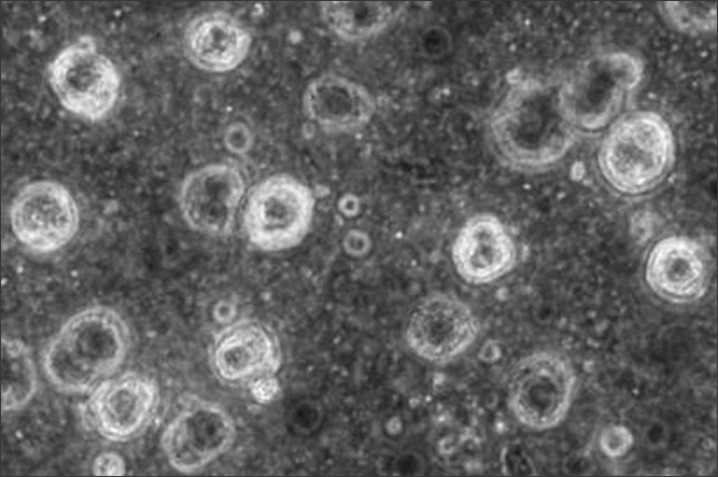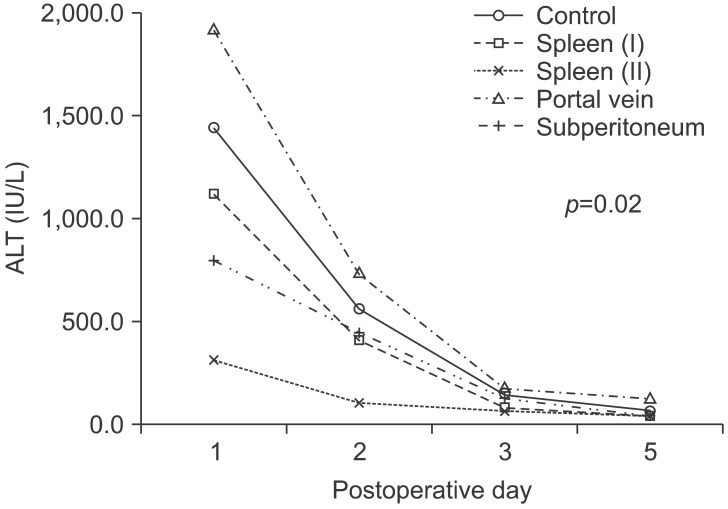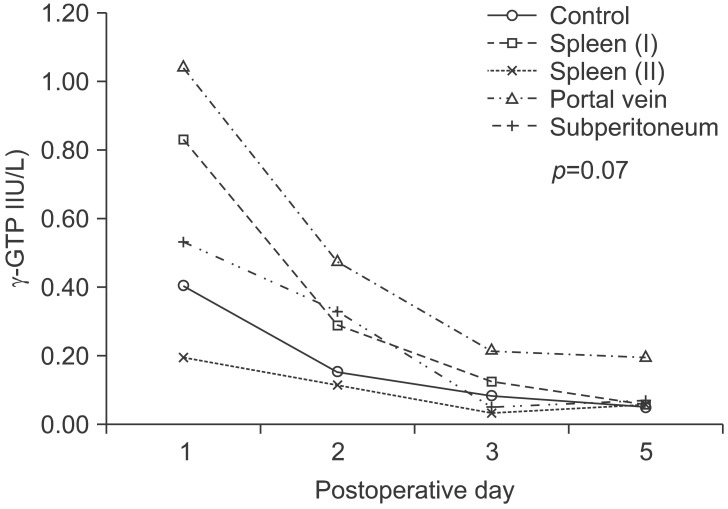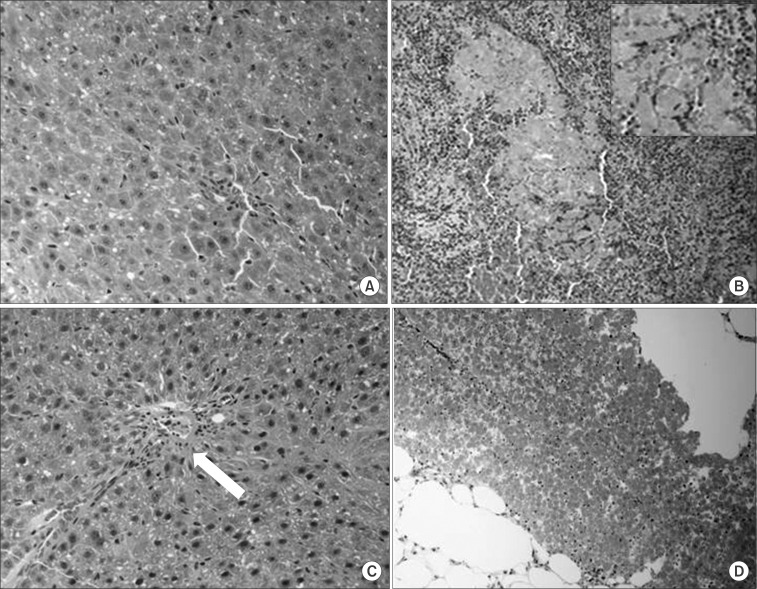Korean J Hepatobiliary Pancreat Surg.
2011 May;15(2):107-116. 10.14701/kjhbps.2011.15.2.107.
Effect of Liver Cell Transplantation on Acute Hepatic Failure Induced by Massive Liver Resection in the Rat
- Affiliations
-
- 1Department of Surgery, Seoul St. Mary's Hospital, The Catholic University of Korea, Korea. kimdg@catholic.ac.kr
- KMID: 1980949
- DOI: http://doi.org/10.14701/kjhbps.2011.15.2.107
Abstract
- PURPOSE
This study is designed to ascertain the most effective quantity and injection route of hepatocytes in an acute liver failure model induced by massive liver resection in rats.
METHODS
Rats weighing 450 to 650 gm underwent partial hepatectomy that was 80% of their liver weight, resulting in acute liver failure. Hepatocytes were obtained by perfusing collagenase (Wako, Japan) solution through portal vein into liver of the allogenic rat. These hepatocytes were injected into different places with different dosage. The experimental groups were divided into the Control group, Splenic group I (2x10(6) cells into splenic capsule), Splenic group II (2x10(7) cells into splenic capsule), Portal vein group (2x10(7) cells into portal vein), Subperitoneal group (2x10(7) cells into subperitoneum). The experimental animals were observed carefully for 5 days for assessment of survival and regeneration of liver. Liver function tests including serum alanine aminotransferase (ALT), total bilirubin, gamma-glutamyl transferase (gamma-GTP) on postoperative 1, 2, 3, 5th days and histologic examinations of specimens obtained from each respective groups on postoperative 5th day were performed.
RESULTS
Serum ALT level on postoperative day 1 peaked and then gradually normalized showing statistical significance (p=0.035). Study groups showing statistically significant difference under repeated anova analysis were between the Splenic group II and Control (p=0.035), and between the Splenic group II and Portal vein group (p=0.001) with respect to serum ALT levels. Also, progression of each study group showed statistical significance. (p=0.02). Serum total bilirubin and r-GTP did not show any significant difference.
CONCLUSION
Hepatocyte transplantation of 2x10(7) cells into spleen showed the best results in the acute hepatic failure rat.
Keyword
MeSH Terms
Figure
Reference
-
1. Gill RQ, Sterling RK. Acute liver failure. J Clin Gastroenterol. 2001; 33:191–198. PMID: 11500606.
Article2. Gotthardt D, Riediger C, Weiss KH, et al. Fulminant hepatic failure: etiology and indications for liver transplantation. Nephrol Dial Transplant. 2007; 22(Suppl 8):viii5–viii8. PMID: 17890263.
Article3. Debray D, Yousef N, Durand P. New management options for end-stage chronic liver disease and acute liver failure: potential for pediatric patients. Paediatr Drugs. 2006; 8:1–13. PMID: 16494508.4. Kjaergard LL, Liu J, Als-Nielsen B, Gluud C. Artificial and bioartificial support systems for acute and acute-on-chronic liver failure: a systematic review. JAMA. 2003; 289:217–222. PMID: 12517233.5. Demetriou AA, Brown RS Jr, Busuttil RW, et al. Prospective, randomized, multicenter, controlled trial of a bioartificial liver in treating acute liver failure. Ann Surg. 2004; 239:660–667. PMID: 15082970.
Article6. Bumgardner GL, Fasola C, Sutherland DE. Prospects for hepatocyte transplantation. Hepatology. 1988; 8:1158–1161. PMID: 3047038.
Article7. Strom SC, Fisher RA, Thompson MT, et al. Hepatocyte transplantation as a bridge to orthotopic liver transplantation in terminal liver failure. Transplantation. 1997; 63:559–569. PMID: 9047152.
Article8. Higgins GM, Anderson RM. Experimental pathology of the liver I Restoration of the liver of the white rat following surgical removal. Arch Pathol. 1931; 12:186–202.9. Ostapowicz G, Fontana RJ, Schiødt FV, et al. Results of a prospective study of acute liver failure at 17 tertiary care centers in the United States. Ann Intern Med. 2002; 137:947–954. PMID: 12484709.
Article10. Nardo B, Caraceni P, Puviani L, et al. Successful treatment of CCl4-induced acute liver failure with portal vein arterialization in the rat. J Surg Res. 2006; 135:394–401. PMID: 16780880.
Article11. Tuñón MJ, Alvarez M, Culebras JM, González-Gallego J. An overview of animal models for investigating the pathogenesis and therapeutic strategies in acute hepatic failure. World J Gastroenterol. 2009; 15:3086–3098. PMID: 19575487.
Article12. Fuller BJ. Transplantation of isolated hepatocytes. A review of current ideas. J Hepatol. 1988; 7:368–376. PMID: 3069902.13. Demetriou AA, Reisner A, Sanchez J, Levenson SM, Moscioni AD, Chowdhury JR. Transplantation of microcarrier-attached hepatocytes into 90% partially hepatectomized rats. Hepatology. 1988; 8:1006–1009. PMID: 3047034.
Article14. Demetriou AA, Felcher A, Moscioni AD. Hepatocyte transplantation. A potential treatment for liver disease. Dig Dis Sci. 1991; 36:1320–1326. PMID: 1893819.15. Gäbelein G, Nüssler AK, Morgott F, et al. Intrasplenic or subperitoneal hepatocyte transplantation to increase survival after surgically induced hepatic failure? Eur Surg Res. 2008; 41:253–259. PMID: 18577870.
Article16. He Y, Zhou J, Dou KF, Chen Y. A rat model for acute hepatic failure. Hepatobiliary Pancreat Dis Int. 2003; 2:423–425. PMID: 14599952.17. Roger V, Balladur P, Honiger J, et al. A good model of acute hepatic failure: 95% hepatectomy. Treatment by transplantation of hepatocytes. Chirurgie. 1996; 121:470–473. PMID: 8978143.18. Berry MN, Friend DS. High-yield preparation of isolated rat liver parenchymal cells: a biochemical and fine structural study. J Cell Biol. 1969; 43:506–520. PMID: 4900611.19. Seglen PO. Preparation of isolated rat liver cells. Methods Cell Biol. 1976; 13:29–83. PMID: 177845.20. Groth CG, Arborgh B, Björkén C, Sundberg B, Lundgren G. Correction of hyperbilirubinemia in the glucuronyltransferase-deficient rat by intraportal hepatocyte transplantation. Transplant Proc. 1977; 9:313–316. PMID: 405772.21. Hillan KJ, Burt AD, George WD, MacSween RN, Griffiths MR, Bradley JA. Intrasplenic hepatocyte transplantation in rats with experimental liver injury: morphological and morphometric studies. J Pathol. 1989; 159:67–73. PMID: 2809886.
Article22. Liu XL, Li LJ, Chen Z. Isolation and primary culture of rat hepatocytes. Hepatobiliary Pancreat Dis Int. 2002; 1:77–79. PMID: 14607628.
- Full Text Links
- Actions
-
Cited
- CITED
-
- Close
- Share
- Similar articles
-
- Three Cases of Fulminant Hepatic Failure due to Congestive Heart Failure
- Effect of Intrasplenic Hepatocellular Transplantation into Partially Hepatectomized Rats
- Acute Hepatic Failure after Spinal Surgery in Patient with Liver Cirrhosis: A case report
- Acute Liver Failure Secondary to Hepatic Infiltration of Malignant Melanoma
- Understanding Acute Liver Failure: A Basic Overview of Definition and Treatment

